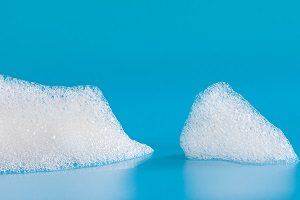Author: Greta Stuthridge
During my grocery shop this week I stopped at the laundry detergents, considering the scent and cost of each brand before picking a floral scented Surf detergent. But what is the environmental impact of that choice?
Doing the weekly washing generates more than clean clothes. Washing machines contribute to almost a quarter of household wastewater or, about 60-180 litres per wash[1]. But what exactly are we sending down our drains?
Laundry detergents are largely composed of surfactants (15%), builders (50%), bleach (7%) and enzymes (2%)[2]. This may seem like a nugatory list of mysterious substances, but understanding their behaviour in our waterways following their discharge from a household is what makes them comprehensible, and frankly, worrying.
Surfactants reduce the surface tension of oil and water, allowing the stains and water to amalgamate, making stains removable[3]. However, surfactants degenerate the protective mucus layer that coats fish, protecting them from parasites and bacteria[4]. Taking away this mucus layer is like removing a human’s immune system, leaving them defenseless. Surfactants also enable aquatic life to absorb pesticides and other pollutants in the water easier. Even low detergent concentrations (2 ppm) can cause fish to absorb twice the amount of chemicals they would usually[5]. Gill damage, however, is the most critical toxic effect of detergent[6]. Surfactants form a micelle (molecules that configure in a spherical form in water) which encloses around the dirt and lifts it away. Micelles are toxic to fish as they infiltrate their gills and impede their capacity to acquire oxygen from the water[7].
Phosphorus in detergent formula is a builder that removes hard water ions, softening the water to enable easier extraction of grime[8]. With 5% of the world’s mined phosphate ending up in laundry detergents, its inevitable presence in our waterways is substantial and harmful[9]. High concentrations of phosphorus interfere with the natural balance of aquatic environments, causing plants, such as algae, to grow far quicker[10]. When the aquatic plants decompose, they use up the oxygen detrimental to the survival of aquatic life[11]. As this cycle repeats, the resource quality of rivers and lakes gradually decreases.
Detergents have been found responsible for disturbing fish reproduction with detergent concentrations as low as 5 ppm killing fish eggs, whilst surfactant detergents decrease the breeding ability of aquatic organisms[12].
Unfortunately, our atmosphere does not go unharmed. The CO2 contribution of laundry detergent is estimated at a staggering 218 Kg CO2 eq/year for every New Zealand household[13].
However, options for action against these damages present themselves to the consumer.
Firstly, who says we need to wear immaculately cleaned clothes every day? Less than ten percent of the average laundry load is heavily soiled[14]. So, if your clothing is free of notable stains or odour, consider it clean and wear it again.
For optimum environmental protection, look for as many eco-claims as possible on detergent packaging. Primarily, Phosphate free; SLS and SLES free (toxic surfactants), neutral PH; biodegradable; No artificial fragrance, colours or preservatives; not tested on animals. Phew!
We can each only do our best. Therefore, all I ask of you is to not choose complacency. Look beyond sale prices and appealing scents next time you purchase laundry detergent. Our fish friends and waterways will thank you for it.
Copyright: Our Environment/Collected thoughts from Victoria University of Wellington’s Environmental Science students. The original content can be found at https://ourenvironment.ac.nz/2019/05/19/the-environmental-impacts-of-laundry-detergent/





